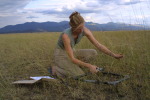
Even when you’re trying to preserve habitat and are addressing a receptive, card-carrying environmentalist audience, “Plant more Schizachyrium scoparium!” just doesn’t have the same impact as “Save the wolf!” or “Bring back the buffalo!”
It’s useless to point out breathlessly that grass, and all plant material down to simple green algae, is the primary and utterly indispensable route through which the sun’s energy makes possible every living thing we see around us. Scant few citizens can be motivated to write their congressional representatives on behalf of phytoplankton.
Think of all the nature shows you’ve seen. There’re guys wrestling alligators and anacondas, there’s Beverly Joubert filming lions fighting hyenas from five feet away (at night), there are divers spurning cages to swim among great white sharks, there’s Timothy Treadwell cuddling grizzlies (wait—that one didn’t turn out so well, did it). Have you ever seen a nature show featuring a rugged-looking guy in a khaki shirt and three-day beard replanting short-grass prairie sod? Have you ever seen any gripping nature show featuring plants?
No, Extreme Loggers doesn’t count.
It might seem tawdry to admit it, but wildlife conservation and habitat preservation, like any other form of advocacy, is largely about salesmanship. And it has to be that way. Biologists cannot expect most people to be conversant in the carbon cycle, or trophic levels, or to be able to correctly answer a question such as, “Which would be worse for humans—if all cattle, goats, chickens, and sheep on earth suddenly disappeared, or if all bacteria on earth suddenly disappeared?” There is a small percentage of the population familiar with the critical technical reasons why we need to preserve large core areas of habitat, intact wildlife movement corridors, heterogeneous forests, and functioning predator/prey systems—not to mention simple clean water and air. But for most of us—the bulk of the population whose votes and emails actually affect policy, and whose donations enable on-the-ground action—conservation frequently hinges not on reason, but on emotion. We need to feel something before we’re willing to do something. And it’s simple human nature that we get more emotional about animals than plants—and more emotional about large splendid animals than small ugly animals. “Save the naked mole rat” wouldn’t work a whole lot better than “Plant more Schizachyrium scoparium.”
That’s how the concept of charismatic megafauna came about. As you’ve probably figured out by now, the term refers to large, splendid animals of the type likely to tug at our emotions. Elephants, tigers, wolves, whales, polar bears—images of these animals make us catch our breath and view the natural world with awe. (There’s a subset I call charismatic cuddly megafauna: pandas, koalas, and the like—plus nearly all the infants of the main set. Similar emotional response, but about two octaves higher.) A conservation organization that builds a fundraising campaign around a member of this broad group has a big head start in achieving its aims—which often extend far beyond saving one species.
If by now you’re beginning to suspect you’ve been being conned by all those emotional pleas focussing on lions and tigers and bears, don’t. Several factors besides charisma combine to put such creatures out front in the conservation community.
First, and most obviously, a lot of them really are endangered, some critically so. Many, if not most, of the charismatic megafauna species are also top-level predators, with the resulting implications of potential competition with humans (stock predation, diminishment in sport-hunting species, even occasional attacks on people). As such, wolves, tigers, lions, and many other carnivorous species have long been the targets of protracted, determined, merciless eradication campaigns only recently curtailed (some not even yet). Also, the mystique and power associated with magnificent animals such as tigers makes them targets for unscrupulous and ruthless purveyors of worthless “medicines” and potions, especially in the Far East. Recent evidence suggests the pushers of products made from tiger bones are switching to lion bones now that tigers are nearly extinct in the wild.
But there’s another factor at work, just as important if not as urgent. The presence of a top-level predator requires an intact habitat with a more or less intact hierarchy of prey species. Biologists use the term trophic levels to explain this. Although it’s far from exact, on a rough basis you can figure that it takes ten pounds of plant material to produce one pound of herbivore, and ten pounds of herbivore to produce one pound of carnivore. So if you have a healthy population of wolves, it’s pretty much a given you also have healthy populations of deer or elk or caribou, and a lot of more or less intact space for plants to grow. And all that open space supports hundreds of species of less-charismatic but equally important animals. In other words, you have a healthy ecosystem. The same effect goes for lions, or tigers, or polar bears.
So remember: When you help save wolves, you just might be saving a whole bunch of Schizachyrium scoparium as well.
